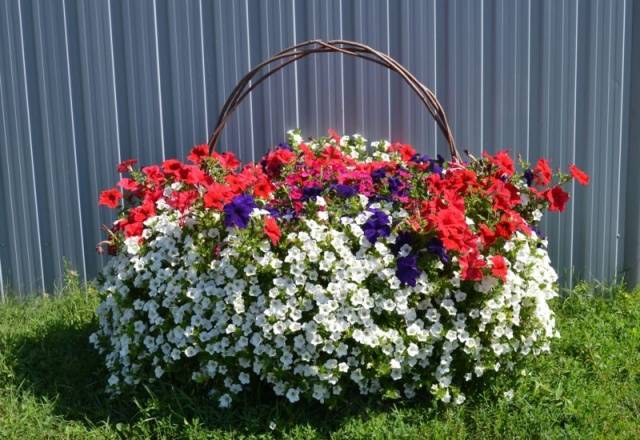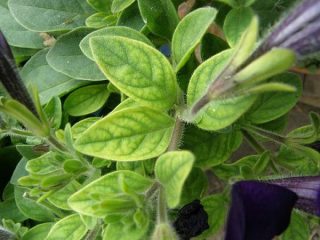Content
Petunias are amazingly beautiful flowers; you can see them in almost every garden. Who would refuse a green cloud strewn with multi-colored “butterflies”. The variety of species and rich color palette allows you to create a unique landscape design. There are bush, ampel and cascade varieties of petunias.
When identifying bush varieties, there are practically no mistakes; hanging and cascading varieties cannot always be distinguished. This is especially difficult for beginners to understand. We will try to give comprehensive answers to the question of what constitutes ampelous and cascading petunia, and what are the differences. But first, let’s describe each of the species of plant groups “arguing” with each other.
Features of ampelous petunia
It is impossible to answer the question of how ampelous petunia differs from cascading petunia without a detailed description of the types of petunias. This is not only the appearance, but also the features of growing and caring for petunias.
Description
The ampelous petunia has its own distinctive features in appearance:
- The length of succulent green shoots can vary, from 30 to 120 cm. During growth, the shoots fall down and do not fall apart. Thanks to this, the plant can be given the desired shape. Therefore, it is grown in hanging containers.
- The size of soft leaves with slight pubescence depends on the age of the petunia: old ones are larger, and young ones are smaller.
- There are many flowers on the plant, they are located along the length of the entire shoot, in the axils. The shape of the flower resembles a bell.
- There are varieties with large flowers with a diameter of up to 10 cm; there are not many of them on the plant. Multi-flowered species have more buds, but they are small in size (from 3 to 8 cm). On one shoot at the same time there can be flowers from 3 to 10 cm. On the same plant, buds can be of different sizes and shades.
- The color palette is rich, from pure white inflorescences to dark purple. Most often, the petals are two-colored, the inside of the bell is a more saturated color.
When planting plants of different colors in one pot, you get an amazingly beautiful flower arrangement, as in this photo.
About the features of forming a bush and obtaining cuttings for propagating petunia in the video:
How to grow ampelous petunia
Annual ampelous petunias are grown as annual plants by sowing seeds for seedlings at the end of March, beginning of April. The seedlings must be picked. It should be planted in a permanent place after warm weather sets in at the end of May, beginning of June, depending on the climatic characteristics of the region.
For growing, you can use hanging pots and boxes.
But you can set aside a separate place in the garden, then the surface will be covered with a carpet of multi-colored buds.
The plant requires watering and feeding, especially during the period of bud formation and flowering. But it cannot tolerate stagnant water in containers: the root system may die, and the succulent shoots at the base also rot.
Hanging varieties are wonderful plants that can be used to decorate terraces, balconies, and pillars. It blooms its first buds at the end of June and delights with its many colors until the first frost.
Petunia cascade
Cascade petunia is a subspecies of ampelous petunia. Although it has its own characteristics.
Description
- Cascading petunias are distinguished by elastic, “well-fed” shoots, which can be up to 1.5 meters long. They don't break even in the wind. The green mass grows due to axillary shoots. Initially, they rise up, and after reaching a certain length, they hang.
- The plant resembles a ball with long hanging vines when planted in a hanging pot.
- The buds are large, up to 5 cm, all flowers on the plant are the same size.
How to properly grow cascade varieties of petunias, watch the video:
Landing Features
Since cascading petunia shoots tend to grow quickly, it can be planted in different ways:
- When grown on the ground, it needs to be given a separate flower bed; the plants scatter vines, forming a flowering clearing with a diameter of up to two meters.
- Supports in the form of pillars and fences are also suitable, you just need to direct the lashes in the right direction. Then the support will be entwined on all sides. When planting, you need to maintain a distance of at least 40 cm, otherwise the plants will choke each other.
- If tubs or wickers are used to grow plants, they must be large in volume, at least 5 liters. If you plan to plant 2-3 plants, you will need a capacity of up to 15 liters.Look at the photo how amazing the flowers look in a wicker basket.
- You can grow petunia on a balcony, loggia, or terrace.
The main thing is to follow the technology of growing and caring for the plant.
How to determine which petunia is in front of you
So, we have looked at each type of petunia separately, now it remains to figure out what the difference is.
The table contains the main indicators that will help you understand this issue.
Description | Ampelnaya | Cascade |
|---|---|---|
Escapes | Up to 120 cm | Up to 150 cm, grow strongly, can wrap around a support. |
Features of growth | They grow straight down and do not spread to the sides. | First up, then down and to the sides. |
Color and size of buds | The flowers are large, up to 10 cm in diameter. The color variety is extensive. One plant can have different sizes and colors. Often two-tone. | The flowers are large and the size of the plant is the same. A varied palette of shades, but one shade. |
Features of cultivation | From seeds and cuttings | From seeds and cuttings. |
Priming | Fertile. | Fertile. |
Watering and fertilizing | Demanding about watering and fertilizing. | Demanding on watering and fertilizing |
Do I need to pinch? | No. | Yes, due to this petunia grows faster |
Where to plant | Hanging flowerpots, spheres, tubs, wickerwork. | Hanging flowerpots, spheres, tubs, wickerwork, in the garden bed as a ground cover plant. |
Bloom | Continuously until frost. | Continuously until frost. |
If you carefully examine the table, you will see that ampelous and cascading petunias have a lot in common.This is not surprising, since the plants are close relatives. Now let’s find out by what signs they can be distinguished:
- The shoots have different lengths and grow differently. You can only pinch them from the cascade variety.
- In a plant with ampels, the shoots are not so juicy and flexible, hence the different strength.
- Cascade petunia can be used as a ground cover plant or for decorating supports and hedges due to its ability to climb. While hanging ones look better in hanging compositions.
- Differences are also observed in the size of the buds. In the cascade variety they are all the same size on the plant. The hanging can have both large and small flowers at the same time. This difference also applies to colors. Ampel varieties can be multi-colored, while cascading varieties are monocolored.
What's more beautiful
We found out how the ampel view differs from the cascade view. But which plants to prefer for growing in the garden is decided by each gardener individually. Look at the photo below how our beautiful petunia decorates homes and yards.
The variety of varieties allows you to create a unique design from petunias: both in hanging pots and on the ground. Some experienced gardeners combine two varieties of petunias or alternate them, coming up with different flower arrangements. The main thing is to follow the rules for growing and caring for petunias.



















